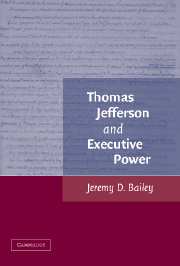Book contents
- Frontmatter
- Contents
- List of Figures and Table
- Preface
- Acknowledgments
- Abbreviations
- 1 “The execution of laws is more important than the making of them”: Reconciling Executive Power with Democracy
- 2 Executive Power and the Virginia Executive
- 3 Executive Power and the Constitution of 1787
- 4 “To place before mankind the common sense of the subject”: Declarations of Principle
- 5 The Real Revolution of 1800: Jefferson's Transformation of the Inaugural Address
- 6 To “produce a union of the powers of the whole”: Jefferson's Transformation of the Appointment and Removal Powers
- 7 The Louisiana Purchase
- 8 To “complete their entire union of opinion”: The Twelfth Amendment as Amendment to End All Amendments
- 9 “To bring their wills to a point of union and effect”: Declarations and Presidential Speech
- Development and Difficulties
- Index
3 - Executive Power and the Constitution of 1787
Published online by Cambridge University Press: 24 July 2009
- Frontmatter
- Contents
- List of Figures and Table
- Preface
- Acknowledgments
- Abbreviations
- 1 “The execution of laws is more important than the making of them”: Reconciling Executive Power with Democracy
- 2 Executive Power and the Virginia Executive
- 3 Executive Power and the Constitution of 1787
- 4 “To place before mankind the common sense of the subject”: Declarations of Principle
- 5 The Real Revolution of 1800: Jefferson's Transformation of the Inaugural Address
- 6 To “produce a union of the powers of the whole”: Jefferson's Transformation of the Appointment and Removal Powers
- 7 The Louisiana Purchase
- 8 To “complete their entire union of opinion”: The Twelfth Amendment as Amendment to End All Amendments
- 9 “To bring their wills to a point of union and effect”: Declarations and Presidential Speech
- Development and Difficulties
- Index
Summary
Between his efforts to reform the Virginia executive and his inauguration as president, Jefferson served as delegate to Congress, minister to France, Secretary of State, and vice president. He also continued to offer reforms for Virginia's legal system, collaborated with republican sympathizers in France, and organized the nation's first opposition party. It is for this period in his life that Jefferson has been most characterized as an enemy of executive power. Indeed, Jefferson seemed to invite such characterizations when demanding a bill of rights, sympathizing with French revolutionaries, or rallying his party against Federalist “monocrats.” When he positioned himself for the presidency, for instance, he contrasted himself from those who desired a more powerful executive, “I am not for transferring all the powers of the States to the general government, & all those of that government to the Executive branch.”
The truth, however, is more complicated. When Alexander Hamilton campaigned against Aaron Burr's election in 1800, he wrote that Jefferson was a “contemptible hypocrite” whose ideas were “tinctured with fanaticism,” but pointed out that Jefferson's tenure as Secretary of State proved that the author of the Declaration was for a strong executive. That is, according to this account, Jefferson's break with Hamilton was over the application of executive power, not the amount of power the executive would have. Accordingly, Ralph Ketcham argues that Jefferson “despised not the idea of an active, independent executive” but, rather, Hamilton's schemes to corrupt the legislative branch and make it the instrument of the Treasury Department.
- Type
- Chapter
- Information
- Thomas Jefferson and Executive Power , pp. 65 - 100Publisher: Cambridge University PressPrint publication year: 2007



